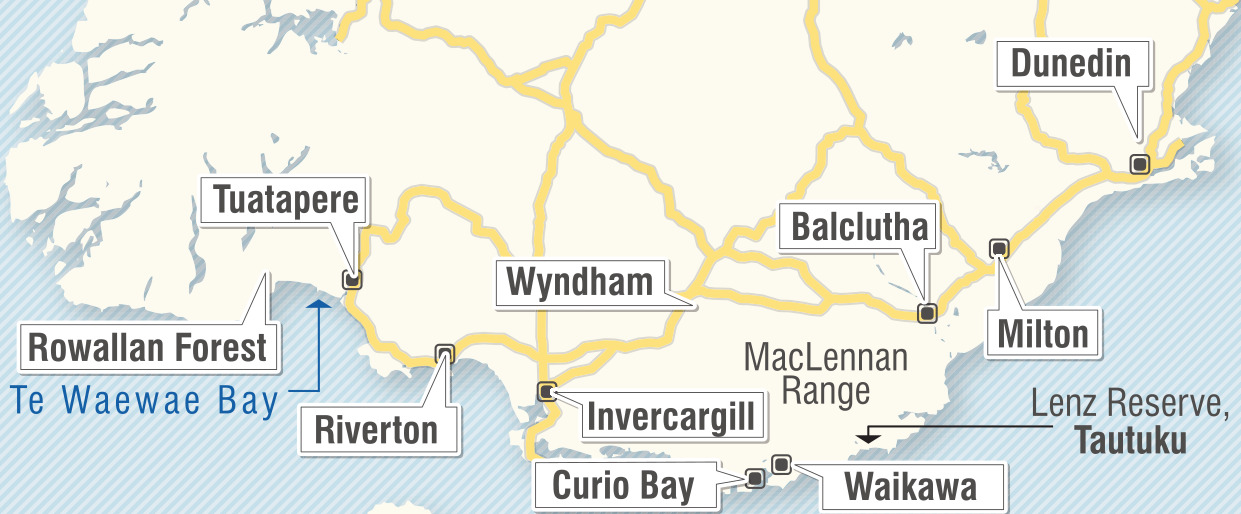
If only mosquitoes would simply poke you with their proboscises, extract their pint then buzz off, it would not be so bad. But no: they then have to locate their victim’s ears and do their little "tee hee hee" dance.
We had driven our electric vehicle with its very small battery from Dunedin, with top-ups at Milton and Balclutha, and were heading for western Southland. The "range anxiety" typical of electric vehicle rookies figured highly in our planning. Not confident of making the long leg from Balclutha to Gore, we plotted a route via the Catlins.

The Lenz Reserve is regenerating after being heavily logged in the bush tramway days, and the old forestry site is worth a visit. There is a remarkable locomotive on display, consisting of three articulated segments interlinked with rotating shafts, all ingeniously powered by a Fordson tractor perched on top. Super-wide metal wheels ran on beams of timber instead of the usual rails. These log haulers were manufactured in Dunedin by the A. and T. Burt company.
Curio Bay was our next stop. The petrified remains of an ancient forest are well-known to Otago visitors, as is the frequency of blustery weather. Today there was a foul, sideways rain-and-sea spray straight from Antarctica, and we wagged the traditional visit to the fossilised forest. We could have sat, petrified, in our EV while charging, but now there is a flash visitor centre with a cafe and audiovisual extravaganza making a visit to Curio Bay viable in all weathers.
Contrasting with the previous glitzy attraction was the little museum in nearby Waikawa: cute as a button, and almost worthy of being in a museum itself. Oh, and more rusty bits of bush tram.

After giving the car a brief defibrillation in Invercargill, we set up camp at Riverton. The holiday park there has a commanding view over the town, and intriguingly is on the Te Araroa tramping route from Cape Reinga to Bluff. There’s an old-school feel about this home away from home: a huge stone fireplace (with logs and instructions provided) welcomes frozen campers. We made good use of another caravan socket, then headed off to explore the Southern Ocean coast further west.
If you have grown up with Canterbury greywacke and Otago schist, the remarkable rocks of Fiordland seem far more interesting. In some sort of tectonic mix-up, Fiordland is geologically part of Nelson, and has all the good stuff. You don't have to tramp through takahe and moose country, because the great rivers wash all the stones out to sea where the prevailing current sweeps them along the beaches, polished to near billiard-ball perfection as they jostle with each other in the waves.

At Te Waewae Bay, the highway turns inland to Tuatapere. This was our next overnight stay, our lodge mostly peopled with rugged tramping types. The town claims the status of sausage capital: this solved our menu decision-making for the evening. On display in the middle of town was another of those bush locomotives, this one had the Fordson tractor notably absent — perhaps it opted for semi-retirement on a farm somewhere.
Our last day of exploration took us to the wildest parts of New Zealand’s bottom-left corner. The road gets narrower and more winding as you head west. We drove through the Rowallan forest to the road end. The celebrated South Coast Track begins here, with its route along abandoned forest tramways and soaring wooden viaducts connecting to the Hump Ridge Track. If you want to go any further, you need to walk. We had come as far as any car could, let alone electric cars.
Now, how to get home ...
- Peter Dowden












